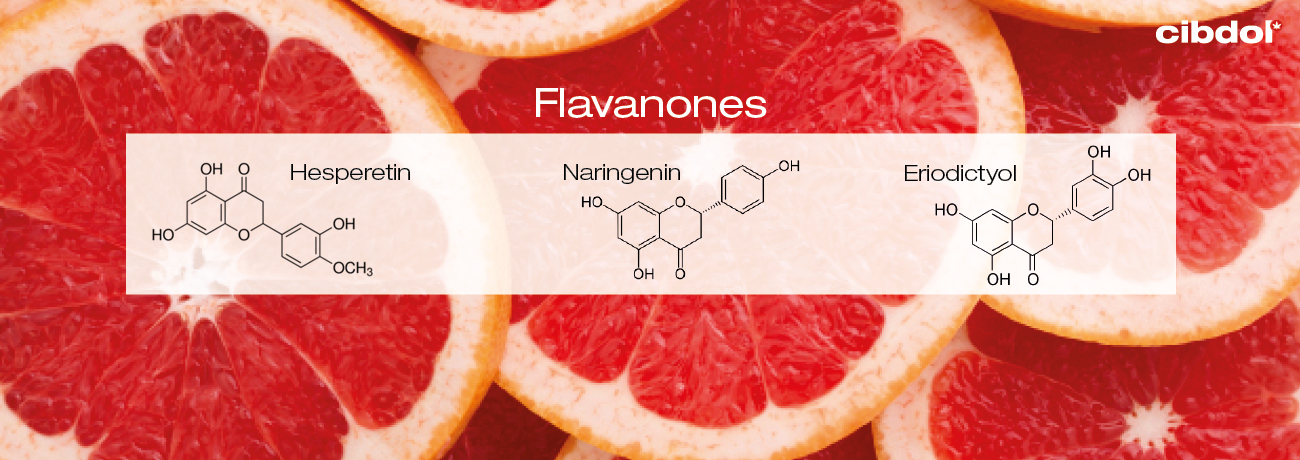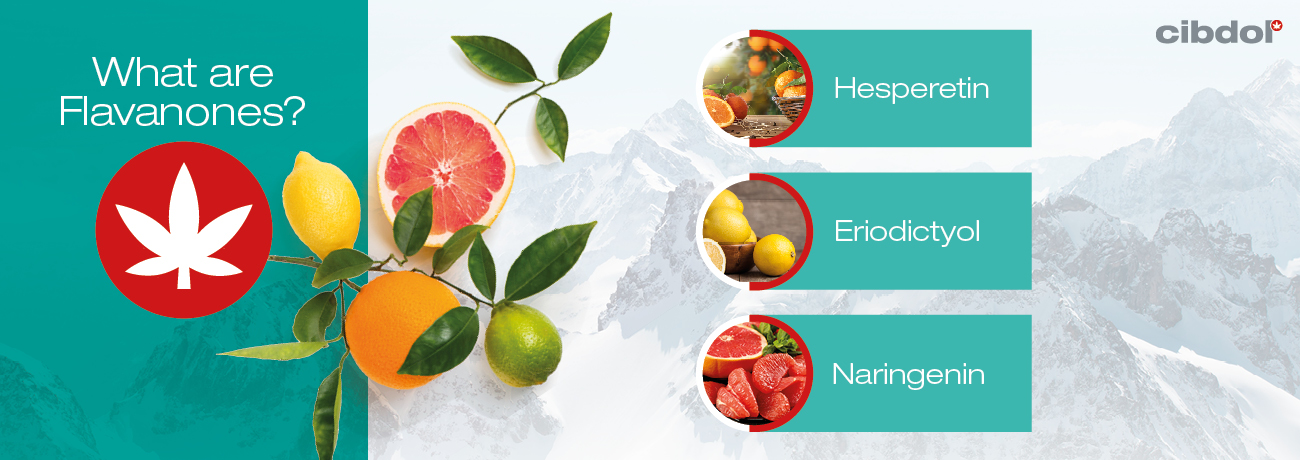What Are Flavanones?
Flavanones are one of six subgroups of phytochemicals called flavonoids.
The flavanone family includes the molecules hesperetin, eriodictyol, and naringenin. Found in various plant species and citrus fruits, early cell, animal, and human studies on the therapeutic potential of flavanones have yielded intriguing results.
Plants produce flavanones as secondary metabolites[1]. These molecules may help plants protect against a range of external threats such as frost, drought, and microbial pathogens. They also might be involved in attracting beneficial insects to increase pollination. Flavanones can be found in almost all parts of a plant, from its branches, stems, barks, and leaves, to the roots, flowers, fruits, peels, and rhizomes.
Continue reading to find out more about these interesting molecules, and how they might benefit humans.
Colour
Flavanones are colourless ketones. Unlike their flavonoid cousins, they aren’t plant pigments.
Also found in
Flavanones occur primarily in citrus fruits, but also appear in other types of plants. They exist in relatively high amounts in artichokes, grapefruits, oranges, limes, lemons, and dried oregano.
Supporting research
Early research suggests that flavanones offer important effects that might help to offset common age-related diseases. Including more of these molecules in one's diet might help to promote health[2] into old age.
So far, research suggests the following effects:
• Cognitive benefits
• Anti-inflammatory
• Antioxidant
• Anticancer
• Cardioprotective
Let’s explore the current research that applies to each of these traits in more detail.
• Cognitive benefits
Research suggests that flavonoids as a whole offer cognitive benefits in adults with cognitive impairment and neurodegenerative diseases. The authors of a paper[3] published in The American Journal of Clinical Nutrition decided to specifically explore flavanones to see if they contributed to these effects in healthy older adults.
They conducted a randomised, double-blind, placebo-controlled study to investigate the cognitive benefits of flavonoid-rich orange juice. The study involved 37 older adults. Researchers divided the participants into two groups. One group received a high-flavanone (305mg) 100% orange juice, whereas the other group received a low-flavanone (37mg) orange-flavoured cordial. After consuming the chosen beverage for eight weeks, the groups swapped over.
The researchers found measures of cognitive function to improve significantly after participants consumed the flavanol-rich orange juice for eight weeks, with no additional effects on mood or blood pressure.
• Anti-inflammatory and antioxidant
Inflammation and oxidative stress underpin many health conditions, including cancer, neurodegenerative diseases, and cardiovascular conditions. Oxidative stress occurs as the result of so-called free radicals. These rogue atoms charge around the body in search of an extra electron, and in doing so cause damage to cells, proteins, and DNA.
Flavanones—particularly hesperetin—appear to act as antioxidants and may help to reduce this type of damage. These molecules serve as free radical scavengers, scooping up rogue atoms and neutralising the threat, in turn reducing further inflammatory instances.
However, hesperetin doesn’t only directly scavenge free radicals; it also helps cells bolster their antioxidant defences[4].
Animal research[5] published in the journal Pharmacological Research also found hesperetin to produce a significant anti-inflammatory effect in regards to ear swelling in mice.
Further cell research found the flavanone to produce anti-inflammatory effects by acting on COX-1 and COX-2. These enzymes produce prostaglandins, inflammatory lipids that promote inflammation, pain, and fever.
• Anticancer
Hesperetin appears to help target tumour cells in several ways. A paper[6] published in Life Sciences details that the flavanone can induce apoptosis by targeting multiple cellular proteins. Apoptosis, or programmed cell death, occurs in normal cells when they become dysfunctional. However, cancer cells manage to avoid this process, enabling them to survive and even spread.
As well as potentially prompting this important mechanism, the flavanone might also help prevent the spread of cancer (metastasis) by targeting COX-2.
• Cardioprotective
Diets supplemented with hesperetin might be beneficial for cardiovascular health. Research[7] published within BioMed Central suggests that the flavanone might regulate LDL in the human liver.
Known as low-density lipoprotein, LDL is the “bad” type of cholesterol that builds up as plaque in the arteries. Through its action, hesperetin may reduce blood levels of LDL and thereby reduce the risk of coronary heart diseases.
Safety and side effects
Flavanones are generally safe molecules. They occur in many popular food items and make up a portion of the daily intake of dietary flavonoids in multiple populations.
[1] Samanta, A., Das, S. K., & Das, G. (2011). Roles of flavonoids in Plants. ResearchGate. Published. https://www.researchgate.net/publication/279499208_Roles_of_flavonoids_in_Plants [Source]
[2] Kozlowska, A., & Szostak-Wegierek, S. (2014). Flavonoids--food sources and health benefits. PubMed. Published. https://pubmed.ncbi.nlm.nih.gov/25272572/ [Source]
[3] Kean, R. J., Lamport, D. J., Dodd, G. F., Freeman, J. E., Williams, C. M., Ellis, J. A., Butler, L. T., & Spencer, J. P. (2015). Chronic consumption of flavanone-rich orange juice is associated with cognitive benefits: an 8-wk, randomized, double-blind, placebo-controlled trial in healthy older adults. The American Journal of Clinical Nutrition, 101(3), 506–514. https://doi.org/10.3945/ajcn.114.088518 [Source]
[4] Parhiz, H., Roohbakhsh, A., Soltani, F., Rezaee, R., & Iranshahi, M. (2014). Antioxidant and Anti-Inflammatory Properties of the Citrus Flavonoids Hesperidin and Hesperetin: An Updated Review of their Molecular Mechanisms and Experimental Models. Phytotherapy Research, 29(3), 323–331. https://doi.org/10.1002/ptr.5256 [Source]
[5] Rotelli, A. (2003). Comparative study of flavonoids in experimental models of inflammation. Pharmacological Research, 48(6), 601–606. https://doi.org/10.1016/s1043-6618(03)00225-1 [Source]
[6] Roohbakhsh, A., Parhiz, H., Soltani, F., Rezaee, R., & Iranshahi, M. (2015). Molecular mechanisms behind the biological effects of hesperidin and hesperetin for the prevention of cancer and cardiovascular diseases. Life Sciences, 124, 64–74. https://doi.org/10.1016/j.lfs.2014.12.030 [Source]
[7] Bawazeer, N. A., Choudhry, H., Zamzami, M. A., Abdulaal, W. H., Middleton, B., & Moselhy, S. S. (2016). Role of hesperetin in LDL-receptor expression in hepatoma HepG2 cells. BMC Complementary and Alternative Medicine, 16(1). https://doi.org/10.1186/s12906-016-1165-2 [Source]
[1] Samanta, A., Das, S. K., & Das, G. (2011). Roles of flavonoids in Plants. ResearchGate. Published. https://www.researchgate.net/publication/279499208_Roles_of_flavonoids_in_Plants [Source]
[2] Kozlowska, A., & Szostak-Wegierek, S. (2014). Flavonoids--food sources and health benefits. PubMed. Published. https://pubmed.ncbi.nlm.nih.gov/25272572/ [Source]
[3] Kean, R. J., Lamport, D. J., Dodd, G. F., Freeman, J. E., Williams, C. M., Ellis, J. A., Butler, L. T., & Spencer, J. P. (2015). Chronic consumption of flavanone-rich orange juice is associated with cognitive benefits: an 8-wk, randomized, double-blind, placebo-controlled trial in healthy older adults. The American Journal of Clinical Nutrition, 101(3), 506–514. https://doi.org/10.3945/ajcn.114.088518 [Source]
[4] Parhiz, H., Roohbakhsh, A., Soltani, F., Rezaee, R., & Iranshahi, M. (2014). Antioxidant and Anti-Inflammatory Properties of the Citrus Flavonoids Hesperidin and Hesperetin: An Updated Review of their Molecular Mechanisms and Experimental Models. Phytotherapy Research, 29(3), 323–331. https://doi.org/10.1002/ptr.5256 [Source]
[5] Rotelli, A. (2003). Comparative study of flavonoids in experimental models of inflammation. Pharmacological Research, 48(6), 601–606. https://doi.org/10.1016/s1043-6618(03)00225-1 [Source]
[6] Roohbakhsh, A., Parhiz, H., Soltani, F., Rezaee, R., & Iranshahi, M. (2015). Molecular mechanisms behind the biological effects of hesperidin and hesperetin for the prevention of cancer and cardiovascular diseases. Life Sciences, 124, 64–74. https://doi.org/10.1016/j.lfs.2014.12.030 [Source]
[7] Bawazeer, N. A., Choudhry, H., Zamzami, M. A., Abdulaal, W. H., Middleton, B., & Moselhy, S. S. (2016). Role of hesperetin in LDL-receptor expression in hepatoma HepG2 cells. BMC Complementary and Alternative Medicine, 16(1). https://doi.org/10.1186/s12906-016-1165-2 [Source]














